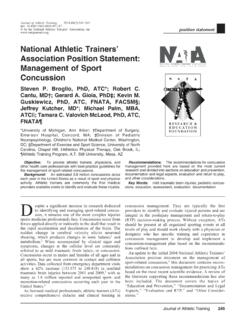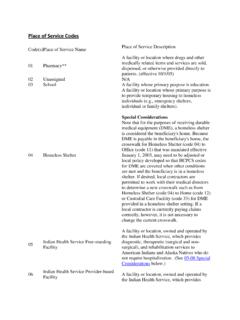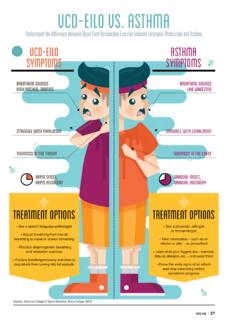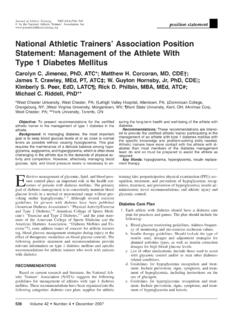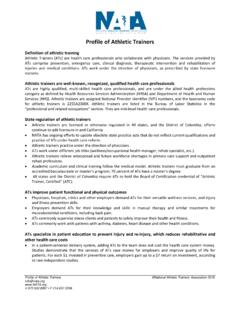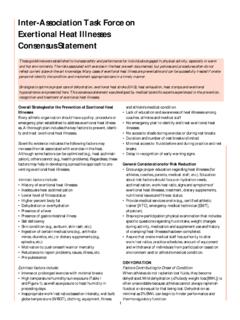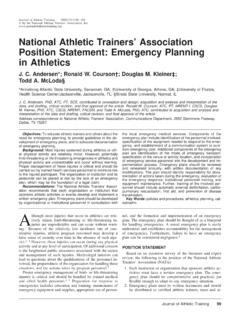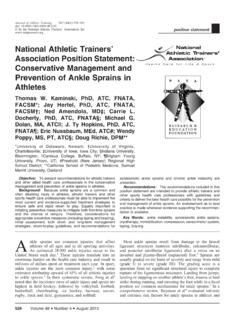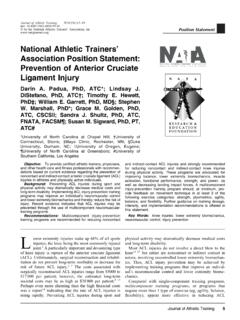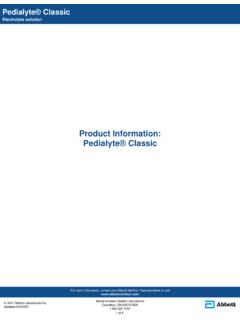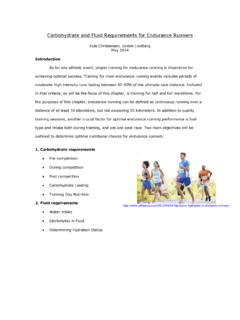Transcription of National Athletic Trainers' Association Position Statement ...
1 National Athletic Trainers AssociationPosition Statement :Fluid Replacement for AthletesDouglas J. Casa, PhD, ATC, CSCS (Chair)*;Lawrence E. Armstrong, PhD, FACSM*; Susan K. Hillman, MS, MA, ATC, PT ;Scott J. Montain, PhD, FACSM ; Ralph V. Reiff, MEd, ATC ;Brent Rich, MD, ATCi; William O. Roberts, MD, MS, FACSM ;Jennifer A. Stone, MS, ATC#*University of Connecticut, Storrs, CT; Arizona School of Health Sciences, Phoenix, AZ; US Army ResearchInstitute of Environmental Medicine, Natick, MA; St. Vincent Hospital, Indianapolis, IN;iArizona State University,Phoenix, AZ; MinnHealth Family Physicians, White Bear Lake, MN; #US Olympic Training Center, ColoradoSprings, COObjective: To present recommendations to optimize thefluid-replacement practices of : Dehydration can compromise Athletic perfor-mance and increase the risk of exertional heat injury.
2 Athletesdo not voluntarily drink sufficient water to prevent dehydrationduring physical activity. Drinking behavior can be modified byeducation, increasing accessibility, and optimizing , excessive overdrinking should be avoided because itcan also compromise physical performance and health. Weprovide practical recommendations regarding fluid replace-ment for : Educate athletes regarding the risks ofdehydration and overhydration on health and physical perfor-mance. Work with individual athletes to develop fluid-replacement practices that optimize hydration status before,during, and after Words: Athletic performance, dehydration, heat illness, hydration protocol, hydration status, oral rehydration solution,rehydrationDuring exercise, evaporation is usually the primarymechanism of heat dissipation.
3 The evaporation ofsweat from the skin s surface assists the body inregulating core temperature. If the body cannot adequatelyevaporate sweat from the skin s surface, core temperature risesrapidly. A side effect of sweating is the loss of valuable fluidsfrom the finite reservoir within the body, the rate being relatedto exercise intensity, individual differences, environmentalconditions, acclimatization state, clothing, and baseline hydra-tion status. Athletes whose sweat loss exceeds fluid intakebecome dehydrated during activity.
4 Therefore, a person with ahigh sweat rate who undertakes intense exercise in a hot,humid environment can rapidly become dehydrated. Dehydra-tion of 1% to 2% of body weight begins to compromisephysiologic function and negatively influence of greater than 3% of body weight further disturbsphysiologic function and increases an athlete s risk of devel-oping an exertional heat illness (ie, heat cramps, heat exhaus-tion, or heat stroke). This level of dehydration is common insports; it can be elicited in just an hour of exercise or evenmore rapidly if the athlete enters the exercise session dehy-drated.
5 The onset of significant dehydration is preventable, orat least modifiable, when hydration protocols are followed toassure all athletes the most productive and the safest purpose of this Position stand is to 1) provide usefulrecommendations to optimize fluid replacement for athletes, 2)emphasize the physiologic, medical, and performance consid-erations associated with dehydration, and 3) identify factorsthat influence optimal rehydration during and after National Athletic Trainers Association (NATA) rec-ommends the following practices regarding fluid replacementfor Athletic participation:1.
6 Establish a hydration protocol for athletes, including arehydration strategy that considers the athlete s sweat rate,sport dynamics (eg, rest breaks, fluid access), environmen-tal factors, acclimatization state, exercise duration, exer-cise intensity, and individual preferences (see Table 1 forexamples of potential outcomes).Address correspondence to National Athletic Trainers Association ,Communications Department, 2952 Stemmons Freeway, Dallas, 35 Number 2 June 2000 Journal of Athletic Training2000;35(2):212 224 by the National Athletic Trainers Association , A proper hydration protocol considers each sport s uniquefeatures.
7 If rehydration opportunities are frequent (eg,baseball, football, track and field), the athlete can consumesmaller volumes at a convenient pace based on sweat rateand environmental conditions. If rehydration must occur atspecific times (eg, soccer, lacrosse, distance running), theathlete must consume fluids to maximize hydration withinthe sport s confines and Fluid-replacement beverages should be easily accessible inindividual fluid containers and flavored to the athlete spreference. Individual containers permit easier monitoringof fluid intake.
8 Clear water bottles marked in 100-mL( oz) increments provide visual reminders to athletesto drink beyond thirst satiation or the typical few water bottles or other hydration systems, whenpractical, during exercise encourages greater fluid Athletes should begin all exercise sessions well status can be approximated by athletes andathletic trainers in several ways (Table 2). Assumingproper hydration , pre-exercise body weight should berelatively consistent across exercise sessions. Determinethe percentage difference between the current body weightand the hydrated baseline body weight.
9 Remember thatbody weight is dynamic. Frequent exercise sessions caninduce nonfluid-related weight loss influenced by timingof meals and defecation, time of day, and calories ex-pended in exercise. The simplest method is comparison ofurine color (from a sample in a container) with a urinecolor chart (Figure). Measuring urine specific gravity(USG) with a refractometer (available for less than $150)is less subjective than comparing urine color and alsosimple to use. Urine volume is another indicator ofhydration status but inconvenient to collect and color analysis or specific gravity, use midstream urinecollection for consistency and accuracy.
10 Remember thatbody weight changes during exercise give the best indica-tion of hydration status. Because of urine and body weightdynamics, measure urine before exercise and check bodyweight (percentage of body weight change) before, during,and after exercise sessions to estimate fluid To ensure proper pre-exercise hydration , the athlete shouldconsume approximately 500 to 600 mL (17 to 20 fl oz) ofwater or a sports drink 2 to 3 hours before exercise and 200to 300 mL (7 to 10 fl oz) of water or a sports drink 10 to20 minutes before Fluid replacement should approximate sweat and urinelosses and at least maintain hydration at less than 2% bodyweight reduction.

